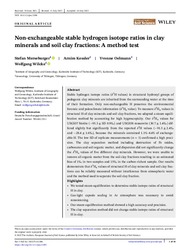Non‐exchangeable stable hydrogen isotope ratios in clay minerals and soil clay fractions: A method test
DOI: https://doi.org/10.1111/ejss.13289
Persistent URL: http://resolver.sub.uni-goettingen.de/purl?gldocs-11858/10429
Persistent URL: http://resolver.sub.uni-goettingen.de/purl?gldocs-11858/10429
Merseburger, Stefan; Kessler, Arnim; Oelmann, Yvonne; Wilcke, Wolfgang, 2022: Non‐exchangeable stable hydrogen isotope ratios in clay minerals and soil clay fractions: A method test. In: European Journal of Soil Science, Band 73, 4, DOI: 10.1111/ejss.13289.
 |
Dokument öffnen: |
Stable hydrogen isotope ratios (δ2H values) in structural hydroxyl groups of pedogenic clay minerals are inherited from the surrounding water at the time of their formation. Only non‐exchangeable H preserves the environmental forensic and paleoclimate information (δ2Hn value). To measure δ2Hn values in structural H of clay minerals and soil clay fractions, we adapted a steam equilibration method by accounting for high hygroscopicity. Our δ2Hn values for USGS57 biotite (−95.3 ± SD 0.9‰) and USGS58 muscovite (30.7 ± 1.4‰) differed slightly but significantly from the reported δ2H values (−91.5 ± 2.4‰ and −28.4 ± 1.6‰), because the minerals contained 1.1%–4.4% of exchangeable H. The low SD of replicate measurements (n = 3) confirmed a high precision. The clay separation method including destruction of Fe oxides, carbonates and soil organic matter, and dispersion did not significantly change the δ2Hn values of five different clay minerals. However, we were unable to remove all organic matter from the soil clay fractions resulting in an estimated bias of 1‰ in two samples and 15‰ in the carbon‐richest sample. Our results demonstrate that δ2Hn values of structural H of clay minerals and soil clay fractions can be reliably measured without interference from atmospheric water and the method used to separate the soil clay fraction.
Highlights
We tested steam equilibration to determine stable isotope ratios of structural H in clay.
Gas‐tight capsule sealing in Ar atmosphere was necessary to avoid remoistening.
Our steam equilibration method showed a high accuracy and precision.
The clay separation method did not change stable isotope ratios of structural H in clay.
Statistik:
ZugriffsstatistikSammlung:
Schlagworte:
controlled isotope exchange techniquedeuterium
montmorillonite
soil clay separation
soil organic matter removal
steam equilibration
structural H
USGS57 biotite
vermiculite
δ2H
This is an open access article under the terms of the Creative Commons Attribution License, which permits use, distribution and reproduction in any medium, provided the original work is properly cited.

